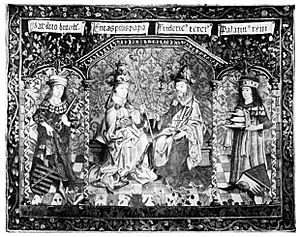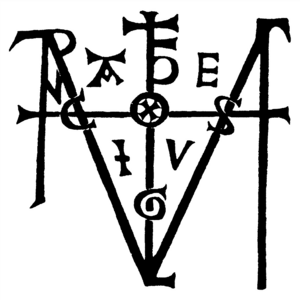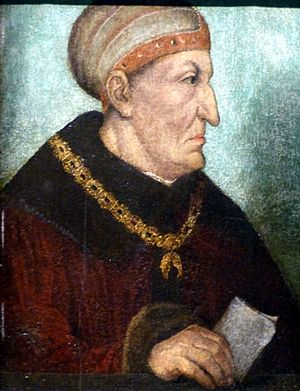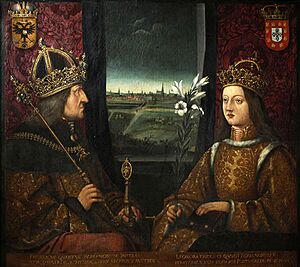Frederick III, Holy Roman Emperor facts for kids
Quick facts for kids Frederick III |
|
|---|---|
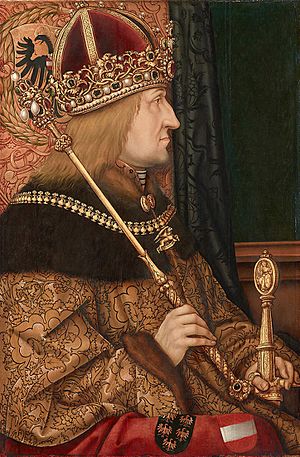
Portrait by Hans Burgkmair, c. 1500
|
|
| Holy Roman Emperor | |
| Reign | 19 March 1452 – 19 August 1493 |
| Coronation | 19 March 1452 |
| Predecessor | Sigismund |
| Successor | Maximilian I |
| King of the Romans | |
| Reign | 2 February 1440 – 19 August 1493 |
| Coronation | 17 June 1442 |
| Predecessor | Albert II |
| Successor | Maximilian I |
| Alongside | Maximilian I (1486–1493) |
| Archduke of Austria | |
| Reign | 23 November 1457 – 19 August 1493 |
| Predecessor | Ladislaus |
| Successor | Maximilian I |
| Alongside | Albert VI (1457–1463) |
| Duke of Styria, Carinthia and Carniola (Inner Austria) |
|
| Reign | 10 June 1424 – 19 August 1493 |
| Predecessor | Ernest |
| Successor | Maximilian I |
| Alongside | Albert VI (1424–1463) |
| Born | 21 September 1415 Innsbruck, Tyrol |
| Died | 19 August 1493 (aged 77) Linz, Austria |
| Burial | St. Stephen's Cathedral, Vienna |
| Spouse | Eleanor of Portugal |
| Issue Detail |
|
| House | Habsburg |
| Father | Ernest, Duke of Austria |
| Mother | Cymburgis of Masovia |
| Religion | Roman Catholicism |
Frederick III (born 21 September 1415 – died 19 August 1493) was a very important ruler in European history. He was the Holy Roman Emperor from 1452 until his death. He was the first emperor from the powerful House of Habsburg family.
Frederick ruled for over 53 years, making him the longest-reigning German monarch of his time. He was also the last Holy Roman Emperor to be crowned in Rome by the Pope. Even though some people called him "Arch-Sleepyhead" during his life, he is now seen as a clever and effective ruler. He helped set up the future Habsburg Empire by making smart family connections and gaining new lands.
Contents
Early Life and Family
Frederick was born in Innsbruck, Tyrol, in 1415. His father was Duke Ernest the Iron, and his mother was Cymburgis of Masovia. Frederick was part of the Leopoldian branch of the Habsburg family. This branch ruled over lands like Styria, Carinthia, and Carniola, which were known as Inner Austria.
When Frederick was only nine years old, his father died in 1424. This made Frederick the Duke of Inner Austria. His uncle, Duke Frederick IV of Tyrol, became his guardian and helped him rule.
Becoming a Ruler
From 1431, Frederick wanted to rule on his own. It took several years, but in 1435, he was finally allowed to govern his lands. His younger brother, Albert, often argued with him about who should rule. This was the start of a long rivalry between them.
Frederick started using a mysterious motto, A.E.I.O.U., which he put on many of his belongings. Its meaning was a secret for a long time. In 1436, he went on a pilgrimage to the Holy Land. This journey earned him a good reputation among nobles.
When his uncle Duke Frederick IV died in 1439, Frederick became the guardian for his young cousin, Sigismund, who was heir to Tyrol. He also became guardian for his nephew Ladislaus the Posthumous in Austria. Frederick was now the main leader of the Habsburg family.
Becoming King and Emperor
In 1440, the important prince-electors chose Frederick to be King of the Romans. This was a step towards becoming Holy Roman Emperor. In 1442, he joined forces with the leader of Zurich in a war against the Old Swiss Confederacy, but he lost.
In 1448, Frederick made an agreement with the Holy See (the Pope) called the Concordat of Vienna. This agreement helped manage the relationship between the Habsburg family and the Catholic Church for many years.
In 1452, when he was 37, Frederick traveled to Italy. He went there to marry his bride and to be crowned Holy Roman Emperor. His fiancée was 18-year-old Eleanor, a princess from Portugal. Her dowry (money and goods she brought to the marriage) helped Frederick pay off his debts.
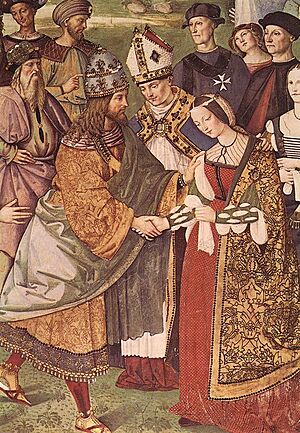
Frederick and Eleanor met in Siena and then went to Rome. On March 16, 1452, Frederick was crowned King of Italy by Pope Nicholas V. A few days later, on March 19, Frederick and Eleanor were married. Then, Frederick was crowned Holy Roman Emperor in St. Peter's Basilica. He was the very last emperor to be crowned in Rome.
Frederick's Personality
Frederick was known for being slow to make decisions. Some people thought this was a weakness. However, others now believe he used this slowness as a way to handle difficult political problems. He was good at waiting out tough situations patiently.
People at the time said Frederick found it hard to be emotionally close to others, even his own family. He was quite distant from his wife, Eleanor. Because of this, Eleanor played a big role in raising and educating their children. This helped the Habsburg family become more powerful. Even though their marriage wasn't always happy, Frederick was sad when Eleanor died and never remarried.
As Emperor
Frederick's actions as emperor were not always bold, but they were often successful in the long run. He faced many challenges, including conflicts with his own family members.
Challenges and Conflicts
One of his main opponents was his brother, Albert VI. Frederick didn't win battles against him directly. Instead, he used clever tactics. He held his young cousin, Ladislaus the Posthumous, who was the ruler of Austria, Hungary, and Bohemia, as a prisoner. Frederick wanted to keep control over Ladislaus's lands. However, Ladislaus was freed in 1452.
Frederick also tried to control his other cousin, Sigismund of Tyrol. Despite his efforts, Frederick failed to gain full control over Hungary and Bohemia. He even lost a war against the Hungarian King Matthias Corvinus in 1485. King Matthias even lived in Vienna for five years after capturing it.
Long-Term Success
Ultimately, Frederick often won by simply outliving his opponents. He inherited their lands, like when he gained Lower Austria after Ladislaus died in 1457. He also took over Upper Austria when his brother Albert VI died.
In 1462, his brother Albert led a rebellion against him in Vienna. Frederick was trapped in his home by his own people. The King of Bohemia, George of Poděbrady, helped Frederick during this time. These conflicts forced Frederick to move his court often, living in places like Graz, Linz, and Wiener Neustadt. He built a castle and a new monastery in Wiener Neustadt.
In 1469, Frederick started the Order of St. George, a special group that still exists today. He also managed to set up new bishoprics (church districts) in Vienna and Wiener Neustadt. This was something no previous Duke of Austria had been able to do.

Frederick played a key role in the marriage of his son, Maximilian, to Mary of Burgundy. Mary was the daughter of Charles the Bold, a very rich and powerful duke. This marriage brought the wealthy lands of Burgundy into the Habsburg family. This was a huge step that helped the Habsburgs become one of the most powerful families in Europe. This event led to the famous saying: "Let others wage wars, but you, happy Austria, shall marry." This became a motto for the Habsburg family.
In 1486, Frederick made sure his son, Maximilian, would become the next King of the Romans. Maximilian was chosen by the electors. Frederick did not give Maximilian full power right away, fearing the electors might take advantage of his son's inexperience.
Frederick's daughter, Kunigunde, married Albert IV, Duke of Bavaria. This marriage was complicated by some political tricks. Albert took control of some imperial lands without permission. He then offered to marry Kunigunde and give her these lands. Frederick initially agreed, but changed his mind when Albert took more land. However, Kunigunde married Albert before her father's change of heart was known. A war was avoided thanks to Maximilian's help.
Frederick's personal motto, A.E.I.O.U., was a mystery. He never explained what it meant. Many ideas were suggested. It is said that before he died, he revealed it meant Austriae Est Imperare Orbi Universali or Alles Erdreich ist Österreich untertan ("All the world is subject to Austria"). This motto likely showed how important he thought his rule and the Habsburg family were.
Marriage and Children
Frederick and Eleanor of Portugal had five children:
- Christoph (1455–1456)
- Maximilian (1459–1519), who became Holy Roman Emperor. He married Mary of Burgundy and later Bianca Maria Sforza.
- Helene (1460–1462)
- Kunigunde (1465–1520), who married Albert IV, Duke of Bavaria.
- Johannes (1466–1467)
For the last 10 years of Frederick's life, he and his son Maximilian ruled together.
Death and Legacy
In his final years, Frederick stayed mostly in Vienna and Linz. In February 1493, his health got worse. Doctors found a problem with his left leg, which was likely due to poor circulation. On June 8, 1493, part of his leg had to be removed in an operation. This was one of the most famous surgeries of the Middle Ages.
Frederick survived the operation at first, but he died on August 19, 1493, in Linz, at the age of 77. People at the time thought he died from the leg operation, old age, or even eating too much melon.
His amazing tomb is in St. Stephen's Cathedral, Vienna. It was built by Nikolaus Gerhaert von Leyden and is considered one of the most important artworks from the late Middle Ages. The tomb was not finished until 1513, twenty years after Frederick's death. His amputated leg was buried with him.
Heraldry
| Heraldry of Frederick III, Holy Roman Emperor | ||||||
|---|---|---|---|---|---|---|
|
See also
 In Spanish: Federico III del Sacro Imperio Romano Germánico para niños
In Spanish: Federico III del Sacro Imperio Romano Germánico para niños


